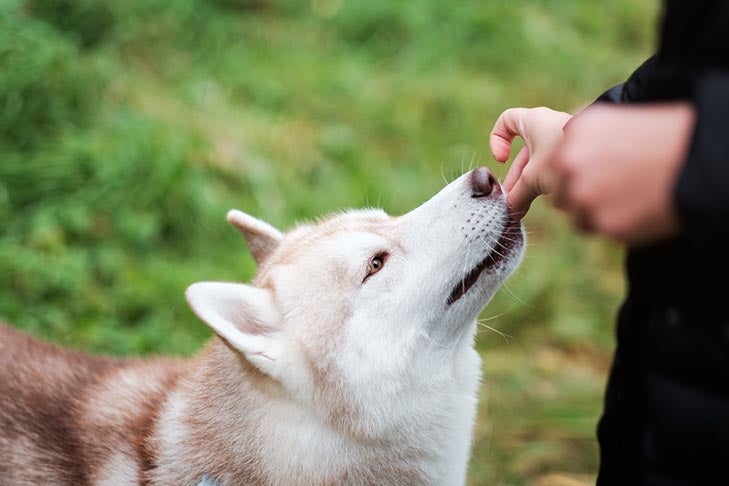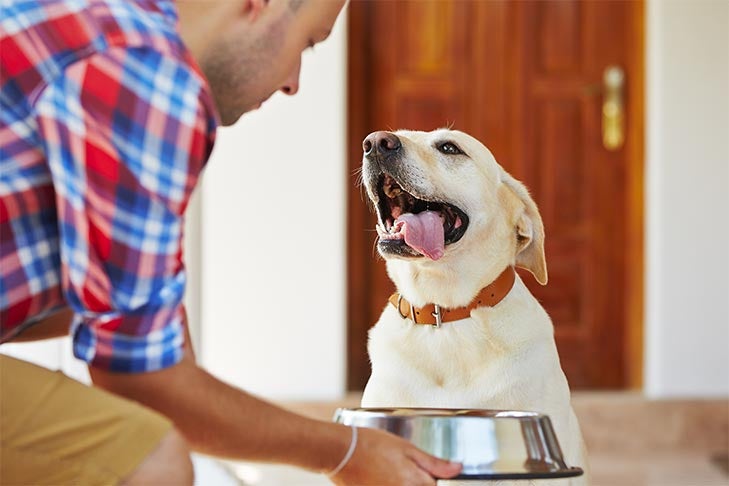AKC GoodDog! Helpline (GDH) is our telephone and video dog training consultation service. We offer live, personalized assistance with your questions about training your puppy or dog. To celebrate GDH’s 10th anniversary in 2023, we’ve rounded up the most common questions that our dog trainers hear from owners just like you. A common question is, “How can I successfully train my dog?”
Dog training is a common struggle for owners, particularly if it’s your first dog. There are so many things you want to teach your pet, but it’s difficult when you don’t speak your dog’s language and your dog doesn’t speak yours. So, how can you positively influence your dog’s behavior in a way they can understand?
Don’t worry. There are ways to train effectively that will help your dog learn faster and easier! These 10 tips will help you become a more successful and effective dog trainer. You and your pet can make steady progress while still having lots of fun.
1. Don’t Expect Your Dog to Work for Free
Just as you’d expect a paycheck for your hard work, dogs deserve to be paid, too. After all, as much as your dog may love you, making you happy isn’t their only goal. Too often, people expect their dogs to listen and behave, just because.
Give your dog positive reinforcement, whether that’s praise, a training treat, or a game of tug-of-war. Without positive reinforcement from you, your dog will look for their own rewards, which usually involves behavior you don’t want, like dragging you down the sidewalk. Instead, “pay” your dog for making good choices, rewarding them when they do what you ask. As a result, when you ask them to perform the same behavior in the future, they’ll want to make those same choices and do what you ask.

2. Figure Out What Your Dog Finds Rewarding
Positive reinforcement training is a powerful way to teach and maintain behavior because dogs repeat behaviors that earn them rewards. But rewards have to be from your dog’s point of view. If your pet isn’t willing to work for something, that item isn’t a reward at all. Top-tier rewards are things your dog really loves, while things on the lower tiers are items they enjoy but aren’t their absolute favorites.
Think about what your dog enjoys and build a hierarchy of their favorite things. Use the lower levels, like dry food or carrot sticks, for easier tasks. Save the top-tier rewards, like pieces of unseasoned chicken breast or playing fetch, when they’re working in distracting environments or learning challenging behaviors.
3. Teach Them That Good Behavior Brings Rewards
The world is full of things your dog wants, such as delicious food, comforting cuddles, and walks outside. And you control access to most of those. If you teach your dog that they’ll get what they want by giving you what you want, it’s a win-win scenario. So don’t give away all the rewards for free.
Instead, ask your dog to perform a behavior before you reward them. For example, ask for a sit before clipping on the leash, or a down before lowering the food bowl. Your dog will quickly learn they gain access to the good stuff simply by listening to your requests.

4. Be Consistent in Your Reactions to Your Dog’s Behavior
You must be consistent with your dog if you want them to learn what you expect. If your reactions change from day to day, you will only confuse your dog and delay your training. That goes for good behaviors as well as bad.
It isn’t helpful for your dog’s learning process if you’re upset about something one day and then you reward that same behavior the next. For example, if you don’t want your dog jumping on you when you’re in your work clothes, don’t allow it when you’re in your sweatpants, either. After all, your dog won’t understand the difference between the two scenarios.
5. Understand That Your Dog’s Learning a New Language
Even puppies are remarkably skilled at reading human body language and gestures, such as pointing. But that doesn’t mean they literally speak your language. To understand us and our training requests, dogs need to learn a whole new language.
So it’s important to be patient and consistently teach them what your words and hand signals mean. For example, if you yell at your dog not to bark at the mail carrier, they won’t understand the meaning of your words. Instead, teach a quiet cue, then reward your dog for obeying when the mail is delivered.
6. Deliver Cues With Consistent Words, Tone, and Body Language
Make it easier for your dog to learn a new language by giving each behavior a single, unique cue. If “down” means “lie down,” it can’t also mean “get down from the couch.” It’s important to deliver cues in the same calm but confident tone.

Make sure every person who works with your dog agrees on the cues you will use for each behavior. That goes for hand signals and other body language too. A raised, open hand often means stay, but if you want to use a fist or other gesture, make sure everybody uses it consistently. This will prevent confusion and help your dog learn faster.
7. Proofing Your Dog’s Behavior
It’s a common complaint that a dog will be attentive to their owner in the kitchen but ignore them when out in the world. The dog isn’t being defiant on purpose. The owner simply didn’t “proof” the sit.
Proofing means ensuring your dog understands the behavior and its cue, no matter the environment or what distractions might be around. Dogs don’t generalize well, so if you teach them to sit while you’re in the kitchen, they will think “sit” only applies in that room. You need to build out the behavior in new locations and the three Ds (distance, duration, and distraction) until your dog will perform the behavior, no matter what.
8. Control Your Emotions
Your emotions can have a big impact on your dog. If you’re anxious, your dog will be anxious. Or if you get overly excited, your dog might become hyper and unable to focus.
Take note of how your mood impacts your dog and adjust accordingly. This is especially important if your dog is reactive (meaning they can overreact in response to certain triggers). It’s embarrassing and frightening when your dog is barking and growling at other dogs or people, but if you get worked up, it will only feed your dog’s reaction. However, if you project an air of relaxed confidence, it will help your dog trust you have things under control.

9. Look at Training From Your Dog’s Perspective
Consider your behavior from your dog’s point of view. Are your cues confusing them? For example, you may be expecting them to stay in a down position while you’re actually luring your dog up with your body language. Do you get tense when other dogs approach? That might be why your dog is barking and snarling when you’re out on walks.
Whenever you hit a training snag, ask yourself what your dog is really learning from you. Seeing the world through your dog’s perspective is a great way to troubleshoot. A professional dog trainer can also help, since they can watch you and your dog and point out any miscommunication.
10. Be an ‘Action Movie’ for Your Dog
The whole world is competing with you for your dog’s attention. After all, why should your dog listen to you when there are squirrels on the horizon? It’s important to be as interesting as you can to your dog in order to hold their concentration.
A good rule of thumb is to be like an action movie — fast-paced, engaging, and easy to follow. When you’re with your dog, really be present with them. Don’t chat with neighbors or scroll on your phone. Make your pet your priority, train at a steady pace, and be clear with your cues. When you pair all that with rewards, your dog will want to follow your every move.
If you need expert advice from experienced trainers or have additional dog training questions, visit the AKC GoodDog! Helpline page for an online chat or to register for the GDH program.
AKC GoodDog! Helpline is celebrating ten years of supporting dog owners. If you need support, experts at AKC GoodDog! Helpline are available by phone or video to answer any training questions that come up, from housetraining your puppy to unwanted behaviors in senior dogs. Join the nearly one million dog owners who trust AKC GoodDog! Helpline today.

